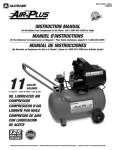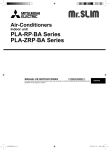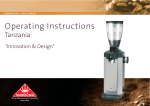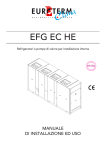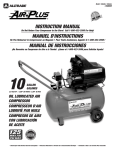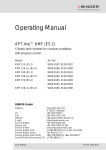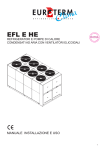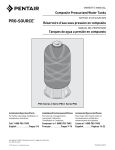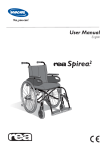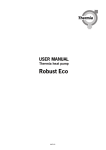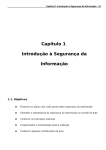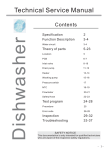Download www.thermia.com
Transcript
Service Instructions Atec www.thermia.com Thermia Värmepumpar is not liable or bound by warranty if these instructions are not adhered to during installation or service. The English language is used for the original instructions. Other languages are a translation of the original instructions. (Directive 2006/42/EC) © Copyright Thermia Värmepumpar Service Instructions Atec Table of Contents 1 About documents and decals . . . . . . . . . . . . . . . . . . . . . . . . . . . . . . . . . . . . . . . . . . . . . . . . . . . . . . . . 1.1 Introduction . . . . . . . . . . . . . . . . . . . . . . . . . . . . . . . . . . . . . . . . . . . . . . . . . . . . . . . . . . . . . . . . 1.2 Symbols in documents . . . . . . . . . . . . . . . . . . . . . . . . . . . . . . . . . . . . . . . . . . . . . . . . . . . . . . . . . . 1.3 Symbols on decals . . . . . . . . . . . . . . . . . . . . . . . . . . . . . . . . . . . . . . . . . . . . . . . . . . . . . . . . . . . . 4 4 4 4 2 Important information/Safety regulation . . . . . . . . . . . . . . . . . . . . . . . . . . . . . . . . . . . . . . . . . . . . . . . . 2.1 General safety precautions . . . . . . . . . . . . . . . . . . . . . . . . . . . . . . . . . . . . . . . . . . . . . . . . . . . . . . . 2.2 Refrigerant . . . . . . . . . . . . . . . . . . . . . . . . . . . . . . . . . . . . . . . . . . . . . . . . . . . . . . . . . . . . . . . . . 2.3 Electrical connection . . . . . . . . . . . . . . . . . . . . . . . . . . . . . . . . . . . . . . . . . . . . . . . . . . . . . . . . . . . 2.4 Water quality . . . . . . . . . . . . . . . . . . . . . . . . . . . . . . . . . . . . . . . . . . . . . . . . . . . . . . . . . . . . . . . . 2.5 Commissioning . . . . . . . . . . . . . . . . . . . . . . . . . . . . . . . . . . . . . . . . . . . . . . . . . . . . . . . . . . . . . . 6 6 7 8 8 9 3 Troubleshooting . . . . . . . . . . . . . . . . . . . . . . . . . . . . . . . . . . . . . . . . . . . . . . . . . . . . . . . . . . . . . . . . . 3.1 Alarm . . . . . . . . . . . . . . . . . . . . . . . . . . . . . . . . . . . . . . . . . . . . . . . . . . . . . . . . . . . . . . . . . . . . . 3.2 Components . . . . . . . . . . . . . . . . . . . . . . . . . . . . . . . . . . . . . . . . . . . . . . . . . . . . . . . . . . . . . . . . 3.3 Measurement points . . . . . . . . . . . . . . . . . . . . . . . . . . . . . . . . . . . . . . . . . . . . . . . . . . . . . . . . . . . 3.4 Check points . . . . . . . . . . . . . . . . . . . . . . . . . . . . . . . . . . . . . . . . . . . . . . . . . . . . . . . . . . . . . . . . 3.5 Operational problems . . . . . . . . . . . . . . . . . . . . . . . . . . . . . . . . . . . . . . . . . . . . . . . . . . . . . . . . . . 10 10 11 12 14 15 Thermia Värmepumpar VIIFM102 3 Service Instructions 1 About documents and decals 1.1 Introduction Atec The following documents are available for this product: ▪ Installation quick guide containing information to install a heat pump. Supplied with the heat pump on delivery. ▪ The Service instructions contain information about the heat pump’s function, accessories, fault tracing and technical data. The instructions also contain tips and advice that should be followed before a heat pump installation. It is therefore recommended that the instructions are read before installation. The Service instructions are available for download as below. ▪ The Wiring diagrams that contain the wiring diagram for the heat pump intended for fault tracing and service. The Wiring diagrams are available for download as below. ▪ The User manual must handed over and gone through with the end customer. Supplied with the heat pump on delivery. ▪ Country specific instructions and forms are available where relevant. Supplied with the heat pump on delivery. ▪ Self-adhesive decals with translation text. Must be placed on the manufacturing plate in conjunction with installation. Supplied with the heat pump on delivery. The Service instructions and Wiring diagrams are available for download here: www.thermia.com/documents 1.2 Symbols in documents The instructions contain different warning symbols, which, together with text, indicate to the user that there are risks involved with actions to be taken. The symbols are displayed to the left of the text and three different symbols are used to indicate the degree of danger: Danger Indicates an immediate danger that leads to fatal or serious injury if necessary measures are not taken. Warning Risk of personal injury! Indicates a possible danger that can lead to fatal or serious injury if necessary measures are not taken. Caution Risk of installation damage. Indicates a possible hazard that can lead to item damage if necessary measures are not taken. A fourth symbol is used to give practical information or tips on how to perform a procedure. N 1.3 Information regarding making the handling of the installation easier or a possible operational technical disadvantage. Symbols on decals The following symbols can occur on decals on the different parts of the heat pump. Which symbols are used depends on the heat pump model. 4 VIIFM102 Thermia Värmepumpar Service Instructions 1.3.1 ! ! Atec General Warning, danger! Warning, hot surfaces! Read the documentation provided. Warning, moving parts! Read the documentation provided. Warning, risk of crushing injury! Warning, hazardous electrical voltage! 1.3.2 3 50 54 55 71 353 362 304 363 365 366 1.3.3 Electrical components Outdoor unit Outdoor sensor Hot water sensor Hot water top sensor Flow guard Drip tray Shunt valve Circulation pump Exchange valve hot water Supply line sensor 406 Room sensor or 62 408 EVU 417 Defrost sensor Explanation Component, ordinary delivery according to proposed system solutions Component, accessorie according to proposed system solutions Return line sensor Pipe connections Tap water Heating system Brine system Defrosting tank Expansion tank with safety valve, brine Air bleeding Temperature and pressure relief valve Outdoor unit Water heater Thermia Värmepumpar VIIFM102 5 Service Instructions 6 Atec 2 Important information/Safety regulation 2.1 General safety precautions Warning Risk of personal injury! Children are not permitted to play with the product. Caution The heat pump must be installed by authorised installation engineers and the installation must follow the applicable local rules and regulations as well as these installation instructions. Caution This product is not intended for persons (including children) with reduced physical, sensory or psychological capacity, or who do not have knowledge or experience, unless supervised or they have received instructions on how the apparatus functions from a safety qualified person. Caution The heat pump must be located in a frost-free environment! Caution The heat pump must be placed in an area with a floor drain. Caution The heat pump must be located on a stable base. The floor must be able to support the gross weight of the heat pump with filled hot water tank (see Technical data). Caution To prevent leaks, ensure that there are no stresses in the connecting pipes! Caution It is important that the heating system is bled after installation. Caution Bleed valves must be installed where necessary. Caution The hot water tank must be equipped with an approved safety valve. Caution Heating systems with closed expansion tanks must also be supplied with approved pressure gauges and safety valves. VIIFM102 Thermia Värmepumpar Service Instructions Atec Caution Cold and hot water pipes and overflow pipes from safety valves must be made of heat resistant and corrosion-resistant material, for example copper. The safety valve overflow pipes must have an open connection to the drain and visibly flow into this in a frost-free environment. Caution The connecting pipe between the expansion tank and the safety valve must slope continuously upwards. A continuous upwards slope means that the pipe must not slope downwards from the horizontal at any point. Caution When cooling it is important to limit the lowest flow line temperature to prevent condensation. N If there is any risk of groundwater infiltration at wall lead-ins for brine pipes, watertight grommets must be used. N In addition to applicable local rules and regulations the installation should be carried out in a manner that prevents vibrations from the heat pump being transmitted into the house causing noise. 2.2 Refrigerant 2.2.1 Refrigerant Caution Work on the refrigerant circuit must only be carried out by a certified engineer! Although the heat pump cooling system (refrigerant circuit) is filled with a chlorine-free and environmentally-approved refrigerant that will not affect the ozone layer, work on this system may only be carried out by authorized persons. 2.2.2 Fire risk The refrigerant is not combustible or explosive in normal conditions. 2.2.3 Toxicity In normal use and normal conditions the refrigerant has low toxicity. However, although the toxicity of the refrigerant is low, it can cause injury (or be highly dangerous) in abnormal circumstances or where deliberately abused. Warning Risk of personal injury! Spaces in which heavy vapour can collect below the level of the air must be well ventilated. Refrigerant vapour is heavier than air and, in enclosed spaces below the level of a door for example, and in the event of leakage, concentrations can arise with a resultant risk of suffocation due to a lack of oxygen. Warning Thermia Värmepumpar Risk of personal injury! Refrigerant exposed to a naked flame creates a poisonous irritating gas. This gas can be detected by its odour even at concentrations below its permitted levels. Evacuate the area until it has been sufficiently ventilated. VIIFM102 7 Service Instructions 2.2.4 Atec Work on the refrigerant circuit Caution When repairing the refrigerant circuit, the refrigerant must not be released from the heat pump, it must treated in the appropriate way. Draining and refilling must only be carried out using new refrigerant (for the amount and type of refrigerant see manufacturer’s plate) through the service valves. Caution 2.2.5 Scrapping Caution 2.3 2.4 8 All warranties from Thermia are void if, when filling with refrigerant other than Thermia Värme AB specified refrigerant, if there has not been written notification that the new refrigerant is an approved replacement refrigerant together with other remedies. When the heat pump is to be scrapped the refrigerant must be extracted for disposal. Local rules and regulations related to the disposal of refrigerant must be followed. Electrical connection Warning Hazardous electrical voltage! The terminal blocks are live and can be highly dangerous due to the risk of electric shock. All power supplies must be isolated before electrical installation is started. The heat pump is connected internally at the factory, for this reason electrical installation consists mainly of the connection of the power supply. Caution Electrical installation may only be carried out by an authorized electrician and must follow applicable local and national regulations. Caution The electrical installation must be carried out using permanently routed cables. It must be possible to isolate the power supply using an all-pole circuit breaker with a minimum contact gap of 3 mm. (The maximum load for externally connected units is 2A). Water quality Caution A normal heating system always contains a certain amount of corrosion particulates (rust) and sludge products from calcium oxide. This comes from acid that is naturally occurring in the fresh water that the system is filled with. It is not good practice to have to fill the heating system regularly which is why any leakage in the heating system should be repaired immediately. Normal filling should occur only once or twice a year. The water in the heating system should be as clean as possible, always position the dirt filter on the return line from the heating system to the heat pump, as close to the heat pump as possible. Caution Hard water; Normally it is not a problem installing a heat pump in areas with hard water because the normal operating temperature for the hot water does not exceed 60°C. In areas where there are exceptional prevailing conditions with the water one can install a softening filter, which softens the water, cleans any impurities and prevents the build up of calcification. VIIFM102 Thermia Värmepumpar Service Instructions 2.5 Atec Commissioning Caution The installation may only be commissioned if the heating system and brine system have been filled and bled. Otherwise the circulation pumps can be damaged. Caution If the installation is only to be driven by the immersion heater during the installation, ensure that the heating system is filled and the brine pump and compressor cannot be started. This is carried out by setting the operating mode to AUX. HEATER. Thermia Värmepumpar VIIFM102 9 Service Instructions 3 Troubleshooting 3.1 Alarm Atec In event of alarm this is indicated in the display with the text ALARM and an alarm message, see following table. For alarms that are not reset automatically acknowledgement is required. Acknowledge the alarm by setting the heat pump to operating mode OFF and then back to the desired operating mode. Message MOTOR P COMP.ERROR MOTOR P FAN ERROR EL. HEATER ERROR HEAT / PRESSURE ERROR Meaning The compressor motor protection has deployed. The fan motor protection has deployed. The electrical heater overheating protection has deployed. The expected pressure and temperature change in the refrigerant circuit has not happened in the correct way at compressor start. LOW PRESSURE ERROR Evaporation pressure has fallen too low. LOW PRESSURE TRANSDUCER Fault in low pressure transmitter alternatively cable fault. HIGH PRESSURE ERROR High pressure switch has deployed. LOW HEAT CIR. FLOW The flow sensor has registered too low a flow. MAX TEMP ELEC. HW Too high temperature in heat pump junction box/electrical cabinet. NO. OF TRIES X/5(where X=1…5) Circulation pump is jammed. Start attempt made. HEATING CIRC. PUMP Circulation pump is jammed. HEATING SYSTEM PUMP Circulation pump is jammed. OUTDOOR SENSOR Sensor fault alternatively cable fault. DEFROST SENSOR Sensor fault alternatively cable fault. Defrost sensor. SUPPLY LINE SENSOR Sensor fault alternatively cable fault. Supply line sensor. SYSTEM SUPPLY LINE SENSOR Sensor fault alternatively cable fault. System supply line sensor. RETURN LINE SENSOR Sensor fault alternatively cable fault. Return line sensor. HIGH RETURN LINE TEMP Return line temperature too high BUFFER TANK SENSOR Sensor fault alternatively cable fault. HGW SENSOR Sensor fault alternatively cable fault. HOT WATER SENSOR Sensor fault alternatively cable fault (the lower sensor, Start sensor). HOT WATER TOP Sensor fault alternatively cable fault. FAILSAFE MODE Sensor fault alternatively cable fault on one of the refrigerant sensors. The heat pump goes to failsafe mode and defrosts on time. REFR.1 SENSOR Sensor fault alternatively cable fault. Refrigerant sensor 1 REFR.2 SENSOR Sensor fault alternatively cable fault. Refrigerant sensor 2 LOW RETURN TEMP 1 The return line temperature is too low to start a defrosting. LOW RETURN TEMP 2 The return line has fallen too low during defrosting. LOW EVAP. TEMP 1 Evaporation temperature too low. LOW EVAP. TEMP 2 Too great a deviation in evaporation temperature average value. SUCTION TEMP SENSOR Sensor fault alternatively cable fault. ROOM SENSOR Sensor fault alternatively cable fault. DISCHARGE PIPE SENSOR Sensor fault alternatively cable fault. DISTR. CIR. 1 SENSOR Sensor fault alternatively cable fault. DISTR. CIR. 2 SENSOR Sensor fault alternatively cable fault. POOL SENSOR Sensor fault alternatively cable fault. COM. ERROR HP-CARD Communication broken between display card and heat pump card (outdoor). COM. ERROR HUB-CARD Communication broken between display card and hub card (indoor). 10 VIIFM102 Thermia Värmepumpar Service Instructions Message COM. ERROR EXV-CARD COM. ERROR EXPANSION CARD Atec Meaning Communication broken between display card and expansion valve control card (outdoor). Communication broken between display card and expansion card (indoor). In event of alarm the heat pump will if possible supply heating to the house, primarily with the compressor, secondarily with the auxiliary heater. Hot water will stop to indicate that something noteworthy has occurred. N 3.2 Components 3.2.1 Outdoor unit 10 1 18 2 19 11 3 4 12 5 13 6 14 7 15 16 17 8 9 Fig. 1: Components Position 1 2 3 4 5 6 Name Electrical cabinet Fan Pressure transmitter Suction line Compressor High pressure switch Thermia Värmepumpar Position 11 12 13 14 15 16 VIIFM102 Name Electronic expansion valve Receiver Drying filter Heat exchanger Flow sensor Heating system supply line 11 Service Instructions Position 7 8 9 10 3.2.2 Atec Name Operating pressure switch Four-way valve Discharge pipe Air heat exchanger Position 17 18 19 Name Return line heating system Solenoid Non-return valve Indoor unit 5 3 4 1 2 Atec Standard 1 4 3 2 Atec Total 1 1. 2. 3. 4. 5. Atec Plus 3.3 Measurement points Caution °C -30 -25 12 Control module (transparent in image) Immersion heater Reversing valve Circulation pump Water heater When reading the resistance of the sensors, the sensor leads must first be disconnected from the control equipment. Outdoor / Defrost sensor 150 ohm, Ω 1884 1443 PT1000 sensor 1000 ohm, Ω – – VIIFM102 Other sensors 22 kilo ohm, kΩ – – Thermia Värmepumpar Service Instructions °C -20 -15 -10 -5 0 5 10 15 20 25 30 35 40 45 50 55 60 65 70 75 80 85 3.3.1 Atec Outdoor / Defrost sensor 150 ohm, Ω 1115 868 681 538 428 343 276 224 183 150 124 103 86 – – – – – – – – – PT1000 sensor 1000 ohm, Ω – – – – 1000 – 1039 – 1078 – 1117 – 1155 – 1194 – 1232 – 1271 – – – Other sensors 22 kilo ohm, kΩ – – – – 66,3 52,4 41,8 33,5 27,1 22,0 18,0 14,8 12,2 10,1 8,5 7,1 6,0 5,0 4,2 3,7 3,1 2,7 Measurement checking sensors during fault tracing 1. Disconnect the relevant sensor from I/O-card/terminal block. 2. Measure the resistance for the sensor and any extension cables. 3. Then measure the sensor only. N Thermia Värmepumpar To ensure the sensor value the actual temperature must be checked against the measured resistance. VIIFM102 13 Service Instructions 3.3.2 Atec Positioning sensors 8 9 7 Atec Total Heat pump 1. 2. 3. 4. 5. 6. 7. 8. 9. 7 DISCHARGE PIPE SENSOR SUCTION TEMP SENSOR REFR.1 SENSOR REFR.2 SENSOR DEFROST SENSOR (located to rear beside air intake) OUTDOOR SENSOR (positioned on wall to north) SUPPLY LINE SENSOR HOT WATER TOP HOT WATER SENSOR RETURN LINE SENSOR - Located on return pipe that runs to heat pump. See system solution in the Installation instructions. Atec Plus 3.4 Check points Temperatures Condensing temperature: Evaporation temperature: Radiator circuit: Overheating R407C: 14 0.5 – 1.5 °C above supply line temperature 7 - 8 °C 8°K temperature difference 4K ±1 K VIIFM102 Thermia Värmepumpar Service Instructions Pressure switch/pressure transmitter Refrigerant R407C OP (operating pressure switch) High pressure switch Pressure transmitter low pressure Atec Break pressure 2.85 MPa 3,10 MPa 0.04 MPa Following parameters can be read off in the display: ▪ Suction gas temperature ▪ Evaporation pressure ▪ Evaporation temperature (calculated from ”Dew point”) ▪ Opening percent EXV ▪ Superheating This means new opportunities to diagnose the heat pump, without having to remove the covers when working on the cooling circuit. ▪ In normal operation the heat pump operates with superheating of 5.5°C – 7°C, the expansion valve's degree of opening will vary depending on operating situation. ▪ At outdoor temperatures of -5°C or lower the opening degree is below 20% ▪ At outdoor temperatures of +5C to +13°C the opening degree is around 40-50% ▪ When cooling (A35W18) the degree of opening is 100% Caution 3.5 If superheating is >9°C and the degree of opening of the expansion valve lies steady at 100% this can indicate that a significant part of the refrigerant has leaked from the heat pump. If this is the case, the heat pump must be checked by service technicians with personal refrigeration certificates! Operational problems The tables list the most probable and common causes of the problem first. When troubleshooting the cause of a problem start with the first cause and go down the list. There may be more than one way of troubleshooting a cause where the most probable is given first. 3.5.1 Alarm Problem – Alarm LP (lower pressure transmitter) Cause Troubleshooting Remedy If a cable has come loose, reconnect it. 1. Cable break or loose cable ▪ Check that both cables are connected to the lower If there is a cable break, replace the cable. to lower pressure transmitpressure transmitter. ter. Using the buzzer, check that there are no cable ▪ breaks. In order to do this, disconnect the cables from the lower pressure transmitter and circuit board. 2. The pressure transmitter opens too soon. 3. Lack of refrigerant, not enough refrigerant in the system. Thermia Värmepumpar Pressure transmitter fault, opens at a higher pressure than indicated. Check break pressure using the manometer apparatus. Using manometer apparatus and thermometer, check that the unit’s overheating is correct for the specific refrigerant. VIIFM102 If the pressure transmitter breaks too early, replace it. Follow the correct procedure (depending on type of refrigerant) to add the correct amount of refrigerant. If there appears to be a leak in the refrigerant circuit, carry out leak tracing and any necessary corrective action. 15 Service Instructions Cause 4. Drying filter blockage. 5. Blocked evaporator on the refrigerant side. Atec Troubleshooting Check the temperature difference above the drying filter. A difference of max 1°C is permissible. If the difference is greater, the filter is blocked. Take a reading during operation. Using manometer apparatus and thermometer, check that the unit’s overheating is correct for the specific refrigerant. Problem – Alarm HP (high pressure switch) Cause Troubleshooting 1. Air in the heating system. Listen for air in the heat pump and heating system. 2. Blocked strainer in the heating system. 3. Closed or partially closed thermostats/valves in the heating system. 4. The circulation pump that is defective or has jammed. Check that the strainer is not blocked. Check that the thermostats/valves in the heating system are open. Remedy If the drying filter is sealed, replace it. If the evaporator is thought to be blocked by oil for example, try blowing nitrogen through it to release the oil. If this does not work, it must be replaced Remedy Bleed the heating system according to the installation instructions. Clean the strainer if necessary. Open closed thermostats/valves. Is there voltage and 0 – 10V signal (applies to A classed cir- Check that the circulation pump is active in culation pumps) up to the circulation pump? the control system’s manual test menu. Check if there is voltage to the circulation pump, if there is, and it does not run, the circulation pump is jammed. If this is the case, open the bleed screw and try to release the paddle wheel using a screwdriver for example (Does not apply to heat pumps in not valid ). If there is no voltage to the circulation pump, check if there is voltage from the I/O card, see wiring diagram. If there is voltage from the I/O card, check the components between the I/O card and the circulation pump. If a component is defective, replace it. 5. Shut-off main tap in heat- Check that the main tap is open. Open closed main tap. ing system. 6. Cable break or loose cable ▪ Check that both cables are connected to the pressure If a cable has come loose, reconnect it. If there is a cable break, replace the cable. to high pressure switch. switch. ▪ Using the buzzer, check that there are no cable breaks. In order to do this, disconnect the cables from the pressure switch and circuit board. 7. The high pressure switch does not open. 16 ▪ Incorrect pressure switch installed. Same or higher break pressure than the high pressure switch. See marking. ▪ Pressure switch fault, opens at a higher pressure than indicated (mark pressure). Check using the manometer apparatus. ▪ Defective pressure switch, never opens. VIIFM102 If the high pressure switch does not open, replace it. Thermia Värmepumpar Service Instructions Atec Cause 8. The high pressure switch opens too soon. Troubleshooting 9. External system shunt that closes on time setting. Check for shunts or valves in the system, which are timer- Always ensure that there is a sufficiently controlled, that close down the entire or too large a part of large water volume for the heat pump to the heating system. work against, i.e. for the heat to give off its heat to. ▪ Check the system’s direction of flow and that the non- If the non-return valve is facing the wrong way, turn it. return valve is turned the correct way. If the non-return valve has too great an ▪ Check that the heat pump’s external available pressure exceeds the non-return valve’s opening pressure. opening pressure, replace it. 10. Incorrectly facing nonreturn valve with too high opening pressure. 11. Large pressure drop in the heating system. 12. Blocked condenser on the water side. ▪ Incorrect pressure switch installed. As low or lower break pressure than operating pressure switch. See marking. ▪ Pressure switch fault, opens at a lower pressure than indicated (mark pressure). Check using the manometer apparatus. ▪ Defective pressure switch, always open. ▪ Dirt in the heating system. ▪ Closed or partially closed thermostats/valves in the heating system. ▪ Under dimensioned pipe system. Check that the HP’s external available pressure exceeds the system pressure drop. If there is no strainer in the heating system, there is a risk of dirt sticking in the condenser and blocking it. Unfortunately there is no easy way of checking if the condenser is blocked. You can carry out a test by allowing the compressor and circulation pumps to remain in operation and after a while, check that the pressure pipe becomes hot and that the circulation pumps work (for circ.pumps with a bleed screw, unscrew it and feel if the pump rotor rotates using a screwdriver). Remedy If the high pressure switch opens too soon or is always open, replace it. If necessary, clean/flush the heating system. Open closed thermostats/valves. If there is not sufficient pressure equipment, the heating system can be adjusted according to the system solution for large pressure drop. If the condenser is thought to be blocked, try flushing it. If this does not work, it must be replaced Then read the temperature on both connection pipes to the condenser: If the temperature difference is <3°C, the condenser is probably blocked. If the temperature difference is 3-13°C, it is probably not blocked. If the temperature difference is >13°C, the condenser is probably blocked. 13. Blocked condenser on Using manometer apparatus and thermometer, check that If the condenser is thought to be blocked the refrigerant side. the unit’s overheating is correct for the specific refrigerant. by oil for example, try blowing nitrogen through it to release the oil. If this does not work, it must be replaced 14. Overfilled refrigerant cir- Using manometer apparatus and thermometer, check that Follow the correct procedure (depending cuit. the unit’s overheating is correct for the specific refrigerant. on type of refrigerant) to add the correct amount of refrigerant. If there appears to be a leak in the refrigerant circuit, carry out leak tracing and any necessary corrective action. Thermia Värmepumpar VIIFM102 17 Service Instructions Atec Problem – Alarm (motor protection) Cause Troubleshooting 1. Phase drop or blown fuse. Check the fuses in the fuse box. Check that all phases are present on the terminal block for incoming supply. Also check that all wiring is secure, if screw terminals are used they must be properly tightened, if phoenix flat spring terminals are used, the cables must be secure in the correct hole with load on the cable. 2. Cable break. Check the supply to the motor protection, soft-starter or compressor. 3. Defective soft-starter Measurement check and establish that when the Heat (three-phase heat pump). pump card gives a signal (there must be voltage between A1 & A2 on the soft-starter), the soft-starter releases all three phases down to the compressor. 4. Defective soft-starter (sin- Check measure and establish that when the Heat pump gle phase heat pump). card gives a signal (there must be voltage between ON and N on the soft-starter), the soft-starter releases the phases to the compressor. 5. Defective or incorrectly Use a hook-on meter to establish when the motor protecset motor protection. tion deploys, check what the motor protection is set to.Compare with the table. For three phase heat pumps all three phases must be supplied. 6. Defective compressor. Measurement check the voltage on the phase(s) (each to zero) at the compressor. There must not be any large deviation between the phases. If measurement checking the winding’s resistance the same value must be on one to three windings. 7. Alarm from single phase Check the fault cause using the soft start LEDs. soft starter. Problem – Alarm sensor (all) Cause Troubleshooting Sensor fault alternatively ca▪ When reading the resistance of the sensors, the senble fault. sor leads must first be disconnected from the control equipment or terminal block. ▪ First take a reading from the sensor including cable and check against the ohm table in Measurement points . ▪ If the read off value does not correspond with the table, only measure the sensor and check the ohm table in Measurement points . Problem – Error phase sequence Cause Troubleshooting The incoming phases have ▪ If the text HEAT / PRESSURE ERROR is displayed it can the incorrect sequence (only mean that the phases are in the incorrect order. applies to 3-phase heat ▪ When the compressor is running, check the pressure pumps), appears after a mipipe temperature by feeling the pressure pipe. If the nute when the compressor phases are correctly sequenced it should be hot (not is started. just warm) even a distance from the compressor. ▪ When the compressor runs with the phases incorrectly sequenced a strange noise may be heard (loud, rattling) when the compressor runs backwards. 18 VIIFM102 Remedy If any of the phases are missing, check backwards towards the building’s main electrical cabinet. If there are no phases there, contact the network supplier. If a cable is damaged, replace it. If the soft-starter does not release the phases when it receives signals from the heat pump card, replace it. If the soft-starter does not release the phases when it receives signals from the heat pump card and does not alarm as below, replace it. If the motor protection is defective, replace it. If incorrectly set, adjust to the correct value. If the compressor is defective, replace it. Remedy If the sensor gives a correct value, the cable is defective. If the sensor does not give a correct value, the sensor is defective. Remedy If the phases are in the incorrect order, switch two incoming phases at the main terminal block and recheck according to the troubleshooting window. Thermia Värmepumpar Service Instructions Atec Problem – Alarm electric heater error Cause Troubleshooting 1. The overheating protecCheck if the overheating protection has tripped. tion has tripped. 2. Phase drop. ▪ Check if the overheating protection has tripped. The alarm occurs when 230 ▪ Check if any cables at the circuit board or overheating V is not registered between protection are loose or damaged. L2 on the circuit board and N. Does not apply if MAX STEP = P. 3. Overheating protection Press the reset button, measurement check for 230 V on fault, cannot be reset. the incoming and outgoing connections. 4. Flow sensor fault. Check what the flow sensor shows. Is it a plausible/actual value? Measure the resistance of the sensor, check against the ohm table in Measurement points . 5. No or insufficient circula- Check: tion in the heating system. ▪ That the circulation pump spins ▪ That the shut-off valves are open. ▪ That the strainer is not blocked. ▪ That there is no air in the heating system. Remedy If the overheating protection has tripped, reset it. If the overheating protection has tripped, reset it. If the cables are loose or damaged, secure or replace them. If the overheating protection is defective, replace it. If the sensor is defective, replace it. The circulation pump may have jammed. If so, open the bleed screw and try to release the paddle wheel using a screwdriver for example. Open closed valves or taps. Check, and, if necessary, clean the strainer. If necessary, bleed the heating system according to the installation instructions Problem – Alarm circulation pump Cause Troubleshooting The circulation pump’s inte▪ Air in the heating system. grated alarm has deployed. ▪ Has the circulation pump jammed? (Only applies to not valid ) Remedy Vent the heating system and TWS coil. If the circulation pump has jammed, there is an integrated shake function that attempts to shake itself loose up to a maximum of 5 times, if it does not succeed, an alarm will occur. Try cutting the voltage to the heat pump to stop the alarm and then manually run the circulation pump.If the alarm recurs, repeat the procedure several times. If this does not help, replace the circulation pump. Thermia Värmepumpar VIIFM102 19 Service Instructions Atec Problem – Operating pressure switch open alternatively high hot gas temperature Cause Troubleshooting 1. Operating pressure 1. Switch off the main switch for the heat pump, wait switch, function. until the compressor has been stationary for at least 15 minutes. 2. Disconnect the two cables on the pressure switch, using a buzzer check if the pressure switch is closed. 2. Fault in the discharge pipe sensor. 3. Hot gas temperature too high. 4. Lack of refrigerant, not enough refrigerant in the system. 3.5.2 Replace the pressure switch if it appears to jam repeatedly. If the discharge pipe sensor is defective, replace it. Check what the discharge pipe sensor shows. Is it a plausible/actual value? Measure the resistance of the discharge pipe sensor, check against the ohm table in Measurement points . The discharge pipe sensor displays more than 140°C. See The square symbol appears when the delivoperating data. ery pipe temperature is as high or greater than the maximum temperature of the discharge pipe 140°C. Using manometer apparatus and thermometer, check that Follow the correct procedure (depending the unit’s overheating is correct for the specific refrigerant. on type of refrigerant) to add the correct amount of refrigerant. If there appears to be a leak in the refrigerant circuit, carry out leak tracing and any necessary corrective action. If leak tracer is not available, brush soap water on the suspected leak and look for bubbles. Also check for oil as this can come out from the refrigerant circuit. Leakage Problem – Leak fluid side Cause 1. Insufficiently tightened connections. 2. Defective gasket or Oring. 3. Cracked nut or connection. 4. There is no overflow pipe connected to the safety valve(s). 5. Filler valve between incoming cold water and heating system not closed or leaking. 20 Remedy If the pressure switch is closed, bridge the pressure switch cables temporarily and switch on the voltage to the heat pump again. If there is an indication 0 (zero) in the display this means that the pressure switch is fault-free and the problem is in the wiring or in the circuit board. If the pressure switch is open, try carefully tapping the head of the pressure switch with a screwdriver and use a buzzer test to see if it has closed again. Troubleshooting Locate the leak. Remedy Locate the leak. Replace the gasket or O-ring. Locate the leak. Replace nut or connection. Establish which safety valve does not have an overflow pipe. Install an overflow pipe according to the applicable norms. Check whether water continuously leaks from the safety valve on the expansion vessel on the hot side. Try closing the filler valve and see if water stops dripping from the safety valve. If not, replace the filler valve. ▪ Tighten the connection and check that it is sealed. ▪ If it is still not sealed, replace the entire connection and support sleeve (only at soft pipes). VIIFM102 Thermia Värmepumpar Service Instructions Cause 6. Leak at soldered joints. 7. Associated leakage in the condenser. Atec Troubleshooting Locate the leak. ▪ Check for lack of refrigerant in the unit. ▪ Check by smelling at the safety valve on the hot side, open the valve and check. 8. Leak at soldered joint on Locate the leak. water heater (only applies to Atec Total Atec Total) 9. Associated leakage on ▪ Check for lack of refrigerant in the unit plate heat exchanger (only ▪ Check by smelling at the safety valve on the hot side, applies to Atec Total Atec open the valve and check. Total) 3.5.3 Remedy Drain the system of fluid, repair the leak.If the leak is on the connection pipe to the heat exchanger, also drain the refrigerant side. If the condenser has a leak, replace it. If there is a leak at the soldered joint, replace the water heater. If there is leakage, replace plate heat exchanger. Noise Problem – Noise problem in the radiator system Cause Troubleshooting 1. Flexible hoses missing. Flexible hoses must be installed according to the instructions. 2. Incorrectly installed flexi- Flexible hoses must be installed according to the instrucble hoses. tions. 3. Installing/suspending Check if vibrations are transmitted via one of the pipe pipes. mountings in the installation. 4. Circulation noise (whisCheck the heating system. tling noise in the heating ▪ Closed valves, choke valves, adjuster valves or other system). restrictions in the radiator system can cause circulation noise. ▪ Is the heating system correctly adjusted for flow? ▪ Too great a flow in the heating system can cause circulation noise. 5. Clicking. Thermia Värmepumpar Remedy Install flexible hoses according to the instructions. Install flexible hoses according to the instructions. Remove or move the mounting point or install vibration isolating mounting parts. If the incorrect type of valve is used to choke the flow, replace with the correct type. If the heating system is not correctly adjusted, make adjustments. Can the heating system be run at a lower flow? A surge tank can be installed on the supply ▪ Check that the volume tank is installed and has the line to mix the hot water with the existing, correct dimensions for the relevant system. See the slightly cooler, water, before it goes out to installation instructions. the radiators. Establish when clicking occurs, during heating and/or ▪ in connection with completed hot water production? Try lubricating lead-ins in walls, ceilings and floors with silicone spray. ▪ Locate the clicking noises. VIIFM102 21 Service Instructions Atec Problem – Loud compressor noise Cause Troubleshooting 1. Phase drop. 1. Check that there is 400 V between incoming phases The compressor attempts to on the heat pump. start or operates on two 2. If there is supply to the heat pump, measure the voltphases (only applies to 3 age for all electrical components all the way to the phase heat pumps) . compressor, see wiring diagram. 2. Touching pipes – vibrations. 3. Compressor fault Establish which pipe(s) is/are causing the problem. Problem – Noise – miscellaneous Cause Troubleshooting 1. Vibrating protective Establish where the vibration noise is coming from. sleeves on the pressure switches. 2. Vibration noise from the Check for electrical steps or similar devices screwed to the electrical installation. heat pump and wall. These can cause vibrations and noise. Remedy If the soft-starter is defective, replace it. Replace the compressor if the valve opens at too low pressure or when the compressor is stationary. Remedy Prevent the protection sleeve vibrating by using insulation tape for example. Carry out according to the installation instructions. Hot-water Problem – Temperature and/or quantity Cause Troubleshooting 1. Defective 3-way valve mo- Check the function of the reversing valve by test running it tor. manually. 2. Jammed reversing valve. Detach the motor and test closing and opening the valve The valve is not secure and by turning the shaft by hand. releases hot water to the radiators during hot water production. 3. Air in TWS coil or water During hot water production: outer jacket. ▪ Listen for air. ▪ Check the temperature difference between supply and return line. 4. Start temperature set too high for hot water production. 22 Try to remove the contact: If the compressor is defective, replace it. Determine whether the compressor is unusually loud. ▪ Check with a voltmeter at a point before and after the soft starter. The measurement values should not differ. Problem – Shrieking, whistling noise Cause Troubleshooting 1. Noise from the soft-start- Measurement check the input and output phases for the er. soft-starter as well as the control signals from the heat pump card, see wiring diagram. 2. The compressor’s safety The compressor has an integrated safety valve that opens valve opens. when the pressure difference between high and low pressure sides is too large. A whistling sound can be heard during pressure equalisation. Use a manometer to check at which pressure differential pressure equalisation occurs. 3.5.4 Remedy Check where the phase drop is and rectify. Check that the start temperature is correctly set. Should not be set above the factory set value. VIIFM102 Remedy If the motor is defective, replace it. If it jams, replace with a new one. Bleed the system. A Large temperature difference can indicate air in the system. ▪ If the start value is set too high, reduce it to the factory set value. Thermia Värmepumpar Service Instructions Cause 5. Sensor fault, hot water sensor. Hot water production is started by the hot water sensor. 6. Large drain flow (>12 l/ min). Atec Troubleshooting Check what the hot water sensor (the start sensor) shows. Is it a plausible/actual value? Measure the resistance of the sensor, check against the ohm table in Measurement points . Check how many litres of hot water (approx. 40°C) per minute drains from the tap.Use a clock and bucket to measure the drain flow. Remedy If the sensor is defective, replace it. If the drain water flow is greater than 12 l/ min, stratification in the water heater is affected, which reduces the hot water capacity. Suggested corrective actions: ▪ Install a pressure reduction valve on the incoming cold water pipe. ▪ Change to a mixer with lower flow. ▪ Adjust the drain flow on the existing mixer, do not open the tap fully. 7. Water heater too small in relation to requirement. How large is the requirement and what is the capacity of the heater? 8. The operating pressure switch opens too soon (at too low a pressure). Hot water production ends when the operating pressure switch opens. 9. Insufficient exchange surface to transfer the heat pump’s output to the heater.(Only applies to heat pumps with a separate heater.) 10. Heat loss in the hot water pipe. Check the break pressure using manometer apparatus. Replace with a larger heater or supplement with an extra heater. E.g. supplement with an MBH MBH or an electric heater. If the pressure switch opens at the incorrect pressure, replace it. The replacement pressure switch can be installed on the service output (Schrader valve). Is the exchange surface too small? Can the heater cope with the heat pump’s output? Replace with a heater with a larger exchange surface. Open the hot water tap, read off the temperature on the outgoing hot water pipe from the heat pump and the temperature of the hot water. The temperature difference measured between the heat pump and hot water indicates the temperature loss. Examples of temperature loss causes: If any problems occur during troubleshooting as per the points, carry out corrective actions. To quickly check that the heat pump’s hot water production works as it should, drain the hot water so that the heat pump starts to produce the hot water. When done, read off the temperature on the top sensor and on the start sensor. The top sensor should show a temperature of around 50 - 55°C and the start sensor around 45 - 48°C. If, after completed hot water production, these temperatures are obtained, this means that you have the correct temperature and volume of hot water in the water heater. ▪ Long water pipes. ▪ Uninsulated hot water pipes. ▪ Hot water pipes routed through cold areas. Other causes that can affect the hot water temperature: ▪ Is a mixer valve installed in the system? Temperature set too low on the mixer valve? Leaking mixer valve? ▪ Water tap fault? Leaking thermostat mixer? ▪ VVC loss. Thermia Värmepumpar VIIFM102 23 Service Instructions 3.5.5 Atec Heating comfort Problem – Too cold Cause 1. The heat pump’s control computer is not set/adjusted to the customer’s requirements/wishes. Troubleshooting Check the ROOM and CURVE and MAX settings. Remedy Adjust incorrect values in the heat pump’s control computer. ROOM = Desired indoor temperature CURVE = Should be set so that the desired indoor temperature (ROOM) is maintained regardless of the outdoor temperature. 2. Incorrect operating mode set in the heat pump’s control computer. 3. Sensor fault, OUTDOOR/ ROOM/SUPPLY LINE/ RETURN LINE. 4. The 3-way valve has jammed in hot water mode. 24 Check which operating mode is set. Check what the relevant sensor shows. Is it a plausible/ actual value? Measure the resistance of the sensor, check against the ohm table in Measurement points . 1. Check the function of the 3-way valve motor by test running it manually. If the motor does not shift mode during manual test operation, check that there is voltage to the motor, see wiring diagram. 2. Detach the motor and test closing and opening the valve by turning the shaft by hand. MAX = Highest set-point value on the supply line regardless of the outdoor temperature. If the incorrect operating mode is set, change to the desired operating mode. If the sensor is defective, replace it. Is the motor being supplied with voltage according to the wiring diagram in both operating instances?MANUAL TEST – REV.V. HOT WATER 0=Radiator mode1=Hot water modeIf there is voltage to the motor but it does not shift mode, replace it. 5. Defective electric heating element. 6. The heat pump has stopped on HIGH RETURN. Use a buzzer and check if all coils in the electric heating el- If the electric heating element is defective, ement are intact. replace it. If the MAX RETURN value is not adjusted for ▪ Check what the MAX RETURN value is set at in the heat pump’s control computer. It must be adjusted to the system according to the troubleshootthe unit’s maximum supply temperature and the sys- ing window, adjust it. tem’s delta temperature so that it does not cut at too If the sensor is defective, replace it. high a return temperature when the highest supply temperature is transmitted. ▪ Check what the return line sensor shows. Is it a plausible/actual value? If not, take a resistance reading from the sensors and check against the ohm table in Measurement points . 7. Heat production is stopped by the HYSTERESIS function. If the flow temperature rises as soon as heat production is stopped by HYSTERESIS before INTEGRAL reaches 0, there may be heating deficit in the house. ▪ Check if heat production stops because the hysteresis value is set too low? (See the installation instructions for factory setting.) ▪ Check if heat production stops because thermostats/ valves in the heating system are closed or partially closed? ▪ Check if heat production stops because the heating system is under dimensioned? VIIFM102 ▪ Try increasing the hysteresis value until the heat pump stops on INTEGRAL instead. ▪ Open thermostats/valves in the heating system and check that the heat pump stops on INTEGRAL. ▪ If the heating system is deemed to be under dimensioned, the system must be extended (the heat emitting surface increased). Thermia Värmepumpar Service Instructions Atec Cause Troubleshooting 8. The auxiliary heater is not Check the set value on MAXSTEP in the heat pump’s conpermitted to cut in with suf- trol computer. ficient output. Value set too low on MAXSTEP. MAXSTEP 2 = 6 kW MAXSTEP 1 = 3 kW MAXSTEP 3 = 9 kW MAXSTEP 2 = 6 kW MAX STEP 4 = 12 kW (cannot cut in when the compressor is running.) MAXSTEP 3 = 9 kW MAXSTEP 4 = 12 kW MAX STEP 5 = 15 kW (cannot cut in when the compressor is running.) MAXSTEP 5 = 15 kW 9. The external auxiliary heater does not start when the heat pump’s control computer requests it. If an external auxiliary heater is used, check that it is correctly installed by test running it in MANUAL TEST – EXT.AUX.HEATER - 1. If it does not start at manual test operation, check that the start signal/voltage comes from the heat pump. See wiring diagram. 10. Closed or partially closed Check that the thermostats/valves in the heating system thermostats/valves in the are open. heating system. 11. The total output of the What is the building’s power demand? heat pump and auxiliary What is the output of the heat pump? heater is too low in relation to the building’s power deWhat is the output of the auxiliary heater, what is it set to? mand. 12. Under dimensioned Check existing heating system. heating system. What output is it dimensioned for to produce at what supply temperature? 13. Changed conditions Have you increased your heating and/or hot water demand? Remedy If necessary, adjust the MAXSTEP value in the heat pump’s control computer.230V 1N MAXSTEP 1 – 3400 V 3-N: MAXSTEP 1 – 5 MAXSTEP 1 = 3 kW Connect the external auxiliary heater according to the instructions. Measure the voltage on the I/O card’s probe L2 Oil/Electricity. Open closed thermostats/valves. Ensure that available power is at least as great as the building’s power demand. If the heating system is dimensioned for greater supply temperatures than the heat pump can provide, it must be adjusted by increasing the heat emitting surface for example. What output is required to keep the room warm? If the room requires a higher output than the heating system can provide, extend the heating system. ▪ If the heat pump has been dimensioned for a certain If the heat pump cannot cope with the dedemand and this demand is increased, the heat pump mand, replace it with one with a higher might not be able to maintain the desired room tem- output or supplement it with a higher output auxiliary heater. perature. ▪ If hot water consumption increases, a larger proportion of time is used to produce hot water, which means less time for heat production (only applies to system solution 1). Thermia Värmepumpar VIIFM102 25 Service Instructions Problem – Too hot Cause 1. The heat pump’s control computer is not set/adjusted to the customer’s requirements/wishes. Atec Troubleshooting Check the ROOM and CURVE and MIN settings. Remedy Adjust incorrect values in the heat pump’s control computer. ROOM = Desired indoor temperature. CURVE = Should be set so that the desired indoor temperature (ROOM) is maintained regardless of the outdoor temperature. 2. Sensor fault, OUTDOOR/ ROOM/SUPPLY LINE. Check what the relevant sensor shows. Is it a plausible/ actual value? Measure the resistance of the sensor, check against the ohm table in Measurement points . 3. Defective 3-way valve mo- Check the function of the 3-way valve motor by test runtor. ning it manually. If the motor does not shift mode during The motor should set the manual test operation, check that there is voltage to the valve to the relevant posimotor, see wiring diagram. tion depending on operating conditions. If it does not, hot water from the water heater will mix with the radiator water. 4. Jammed reversing valve. Detach the motor and test closing and opening the valve If the valve is not sealed, hot by turning the shaft by hand. water from the water heater will mix with the radiator water. 26 VIIFM102 MIN = Lowest set-point value on the supply line regardless of the outdoor temperature. If the sensor is defective, replace it. Is the motor being supplied with voltage according to the wiring diagram in both operating instances? MANUAL TEST – REV.V. HOT WATER 0=Radiator mode 1=Hot water mode If there is voltage to the motor but it does not shift mode, replace it. If it is sluggish or jams, replace with a new one. Thermia Värmepumpar Service Instructions Atec Problem – Irregular indoor temperature Cause Troubleshooting 1. The heat pump’s control Check the ROOM and CURVE, MIN, MAX CURVE5, CURVE0, computer is not set/adjusCURVE-5 and HEAT STOP settings. ted to the customer’s requirements/wishes. Remedy Adjust incorrect values in the heat pump’s control computer. ROOM = Desired indoor temperature CURVE = Should be set so that the desired indoor temperature (ROOM) is maintained regardless of the outdoor temperature. MIN = Lowest set-point value on the supply line regardless of the outdoor temperature (on the condition that heat stop does not apply). MAX = Highest set-point value on the supply line regardless of the outdoor temperature. CURVE5,0,-5 =The supply temperature can be adjusted up or down 5°C at these outdoor temperatures. HEAT STOP = Stops all production of heat when the outdoor temperature is the same as or greater than the set value. To exit heat stop the outdoor temperature must drop to 3°C below the set value. 2. Incorrectly positioned/ installed sensors. Thermia Värmepumpar Check that outdoor sensors and any room sensors are installed according to the instructions and that they are calibrated. VIIFM102 ▪ Check that the room sensor is positioned in a suitable place that is representative of the building and calibrate it if necessary. Avoid placing near external doors, windows and heat sources. ▪ Install the outdoor sensor according to the instructions and calibrate it, if necessary. 27 Service Instructions 3.5.6 Atec Other Problem – The heat pump runs and runs but never stops Cause Troubleshooting 1. Air in the heating system. Listen for air in the heat pump and heating system. 2. Changed conditions Have you increased your heating and/or hot water demand? Remedy Bleed the heating system according to the installation instructions. If the heat pump cannot cope with the de▪ If the heat pump has been dimensioned for a certain demand and this demand is increased, the heat pump mand, replace it with one with a higher might not be able to maintain the desired room tem- output or supplement it with a higher output auxiliary heater. perature. ▪ If hot water consumption increases, a larger proportion of time is used to produce hot water, which means less time for heat production. 3. Lack of refrigerant, not enough refrigerant in the system. Using manometer apparatus and thermometer, check that Follow the correct procedure (depending the unit’s overheating is correct for the specific refrigerant. on type of refrigerant) to add the correct amount of refrigerant. If there appears to be a leak in the refrigerant circuit, carry out leak tracing and any necessary corrective action. If leak tracer is not available, brush soap water on the suspected leak and look for bubbles. Also check for oil as this can come out from the refrigerant circuit. Problem – Runs on electric heating element Cause Troubleshooting 1. Operating mode AUX. If this operating mode is selected, the auxiliary heater is HEATER is selected. used for heating and hot water production, not the compressor. Remedy If AUX. HEATER mode is selected and you no longer want it, change to AUTO, the heat pump then controls both the compressor and auxiliary heater. 2. The compressor cannot Check the alarm that is indicated in the display. Rectify the problem and rest the alarm. See run due to an alarm. Alarm . 3. The integral value has Check what the integral value is in the control system. If the auxiliary heater is in operation bereached the start level for cause the integral value has counted down the auxiliary heater. to the start value, the computer reacts as it should, see the Installation instructions for further information. 4. Peak heat operation (anti- Check if the heat pump runs peak heat. Peak heat operation occurs in connection legionella function) is runwith hot water production with the set inning. terval. The compressor should then start to produce hot water and 2 minutes later the auxiliary heater starts. The compressor must then stop and the stop temperature be reached with only the auxiliary heater connected. Take no corrective action. If the MAX RETURN value is not adjusted for 5. The heat pump has stop▪ Check what the MAX RETURN value is set at in the ped on HIGH RETURN. heat pump’s control computer. It must be adjusted to the system according to the troubleshootthe unit’s maximum supply temperature and the sys- ing window, adjust it. tem’s delta temperature so that it does not cut at too If the sensor is defective, replace it. high a return temperature when the highest supply temperature is transmitted. ▪ Check what the return line sensor shows. Is it a plausible/actual value? If not, take a resistance reading from the sensors and check against the ohm table in Measurement points . 28 VIIFM102 Thermia Värmepumpar Service Instructions Atec Cause Troubleshooting 6. The compressor runs ▪ If the text ERR PHASE SEQ. appears in the display backwards.The incoming when the heat pump is powered, (only appears in the phases have the incorrect first 10 minutes) this means that the phases have the sequence (only applies to 3incorrect sequence. phase heat pumps). ▪ When the compressor is running, check the pressure If the compressor runs backpipe temperature by feeling the pressure pipe. If the wards, it will not cope with phases are correctly sequenced it should be hot (not compressing the refrigerant just warm) even a distance from the compressor. and therefore does not proWhen the compressor runs with the phases incorrect▪ duce the correct power, ly sequenced a strange noise may be heard (loud, ratwhich leads to the control tling) when the compressor runs backwards. system requesting auxiliary heating. 7. Changed conditions Have ▪ If the heat pump has been dimensioned for a certain you increased your heating demand and this demand is increased, the heat pump and/or hot water demand? might not be able to maintain the desired room temperature. ▪ If hot water consumption increases, a larger proportion of time is used to produce hot water, which means less time for heat production. Problem – The auxiliary heater is in operation but not the compressor Cause Troubleshooting 1. Operating mode AUX. If this operating mode is selected, the auxiliary heater is HEATER is selected. used for heating and hot water production, not the compressor. 2. Peak heat operation (anti- Check if the heat pump runs peak heat. legionella function) is running. 3. The compressor cannot run due to an alarm. 4. The heat pump has stopped on high return. Thermia Värmepumpar Check the alarm that is indicated in the display. ▪ Check what the MAX value is set at in the heat pump’s control computer. It must be adjusted to the unit’s maximum supply temperature and the system’s delta temperature so that it does not cut at too high a return temperature when the highest supply temperature is transmitted. ▪ Check what the return line sensor shows. Is it a plausible/actual value? If not, take a resistance reading from the sensors and check against the ohm table in Measurement points . VIIFM102 Remedy If the phases are in the incorrect order, switch two incoming phases at the main terminal block and recheck according to the troubleshooting window. If the heat pump cannot cope with the demand, replace it with one with a higher output or supplement it with a higher output auxiliary heater. Remedy If AUX. HEATER mode is selected and you no longer want it, change to AUTO, the heat pump then controls both the compressor and auxiliary heater. Peak heat operation occurs in connection with hot water production with the set interval. The compressor should then start to produce hot water and 2 minutes later the auxiliary heater starts. The compressor must then stop and the stop temperature be reached with only the auxiliary heater connected. Take no corrective action, this is normal. Rectify the problem and rest the alarm. ▪ If the MAX RETURN value is not adjusted for the system according to the troubleshooting window, adjust it. ▪ If the sensor is defective, replace it. 29 Service Instructions Atec Cause 5. The compressor has been stopped by the operating pressure switch or delivery line sensor. Troubleshooting Check if a square appears in the display’s lower left corner. If so, the operating pressure switch is open or the delivery pipe sensor triggers an alarm for too high temperature. Remedy If the operating pressure switch has stuck in the open position, try gently tapping on the pressure switch head. If this does not help, or it sticks in the open position repeatedly, replace the pressure switch. If the ▪ The operating pressure switch is most easily checked delivery line sensor is defective, replace it. If by using a buzzer to see if it is connected. the delivery line temperature gets so hot ▪ The pressure pipe sensor value is read off from the that the compressor stops, start by leakcontrol system in the HEAT PUMP menu. Is it a plausi- tracing the unit. Rectify the leak, if a leak is ble/actual value? If not, take a resistance reading from found. If no leak is found, try draining and the sensor and check against the ohm table in Meas- refilling the unit and then restarting the urement points . heat pump and seeing what the delivery ▪ The compressor has been stopped by the delivery line line temperature is. If the problem persists, sensor and you have established that it shows the replace the compressor. correct temperature. This may have been caused by a leak in the refrigerant circuit. 6. The compressor runs backwards. The incoming phases have the incorrect sequence (only applies to 3phase heat pumps). If the compressor runs backwards, it will not cope with compressing the refrigerant and therefore does not produce the correct power, which leads to the control system requesting auxiliary heating. ▪ If the text ERR PHASE SEQ. appears in the display when the heat pump is powered, (only appears in the first 10 minutes) this means that the phases have the incorrect sequence. ▪ When the compressor is running, check the pressure pipe temperature by feeling the pressure pipe. If the phases are correctly sequenced it should be hot (not just warm) even a distance from the compressor. ▪ When the compressor runs with the phases incorrectly sequenced a strange noise may be heard (loud, rattling) when the compressor runs backwards. 7. The built-in overheating protection (bi-metal protection) in the compressor has tripped. Check if the heat pump’s control computer indicates that the compressor is in operation, and if there is voltage in the soft-starter control inputs. Then read off and check that there is voltage on the compressor’s electrical connection(s). Problem – The heat pump consumes too much energy Cause Troubleshooting 1. Blocked strainer in the Check that the strainer is not blocked. heating system. 2. The compressor cannot Check the alarm that is indicated in the display. run due to an alarm. 3. Incorrect flow over hot Measurement check what the difference between the supside of the heat pump. ply and return line is using a thermometer (∆t). The difference should be about 8°C (can vary depending on refrigerant). A lower ∆t results in reduced efficiency in the heat pump. 4. The heat pump’s control Check the ROOM and CURVE and MIN settings. computer is not set/adjusted to the customer’s requirements/wishes. 30 VIIFM102 If the phases are in the incorrect order, switch two incoming phases at the main terminal block and recheck according to the troubleshooting window. If there is voltage on the compressor’s electrical connection(s) and the overheating protection does not close when the compressor has not run and has cooled down for at least 1 hour, replace the compressor. Remedy Clean the strainer if necessary. Rectify the problem and rest the alarm. See section Alarm . Adjust the system to obtain the correct ∆t. Adjust incorrect values in the heat pump’s control computer. ROOM = Desired indoor temperature CURVE = Should be set so that the desired indoor temperature (ROOM) is maintained regardless of the outdoor temperature. MIN = Lowest set-point value on the supply line regardless of the outdoor temperature. Thermia Värmepumpar Service Instructions Atec Cause Troubleshooting 5. The interval for peak heat Check the specified interval for peak heat operation in the operation has changed to a control computer. lower value than the factory set value. This results in the heat pump going into peak heat operation more often than calculated. 6. The heat pump has stop▪ Check what the MAX RETURN value is set at in the ped on HIGH RETURN. heat pump’s control computer. It must be adjusted to the unit’s maximum supply temperature and the system’s delta temperature so that it does not cut at too high a return temperature when the highest supply temperature is transmitted. ▪ Check what the return line sensor shows. Is it a plausible/actual value? If not, take a resistance reading from the sensors and check against the ohm table in Measurement points . Remedy If there is a shorter interval between the peak heat productions, this explains why the unit consumes more current than calculated, but this does not mean for sure that it should be increased, there might be a reason why the interval has been changed. 7. The compressor runs ▪ If the text ERR PHASE SEQ. appears in the display backwards. The incoming when the heat pump is powered, (only appears in the phases have the incorrect first 10 minutes) this means that the phases have the sequence (only applies to 3incorrect sequence. phase heat pumps). If the ▪ When the compressor is running, check the pressure compressor runs backwards, pipe temperature by feeling the pressure pipe. If the it will not cope with comphases are correctly sequenced it should be hot (not pressing the refrigerant and just warm) even a distance from the compressor. therefore does not produce When the compressor runs with the phases incorrect▪ the correct power, which ly sequenced a strange noise may be heard (loud, ratleads to the control computtling) when the compressor runs backwards. er requesting auxiliary heating. 8. The compressor has been Check if a square appears in the display’s lower left corner. stopped by the operating If so, the operating pressure switch is open or the delivery pressure switch or delivery pipe sensor triggers an alarm for too high temperature. line sensor. If the phases are in the incorrect order, switch two incoming phases at the main terminal block and recheck according to the troubleshooting window. 9. Expansion valve defective or incorrectly set. 10. Lack of refrigerant, not enough refrigerant in the system. If the expansion valve is defective, replace it. If there appears to be a leak in the refrigerant circuit, carry out leak tracing and any necessary corrective action. If leak tracer is not available, brush soap water on the suspected leak and look for bubbles. Also check for oil as this can come out from the refrigerant circuit. If the MAX RETURN value is not adjusted for the system according to the troubleshooting window, adjust it. If the sensor is defective, replace it. If the operating pressure switch has stuck in the open position, try gently tapping on the pressure switch head. If this does not help, or it sticks in the open position repeatedly, replace the pressure switch. If the ▪ The operating pressure switch is most easily checked delivery line sensor is defective, replace it. If by using a buzzer to see if it is connected. the delivery line temperature gets so hot ▪ The delivery line sensor value is read off from the con- that the compressor stops, start by leaktrol computer in the HEAT PUMP menu. Is it a plausi- tracing the unit. Rectify the leak, if a leak is ble/actual value? If not, take a resistance reading from found. If no leak is found, try draining and the sensor and check against the ohm table in the in- refilling the unit and then restarting the stallation instructions. heat pump and seeing what the delivery ▪ The compressor has been stopped by the delivery line line temperature is. If the problem persists, sensor and you have established that it shows the replace the compressor. correct temperature. This may have been caused by a leak in the refrigerant circuit. Thermia Värmepumpar Using manometer apparatus and thermometer check what the overheating reading of the unit is. Using manometer apparatus and thermometer, check that the unit’s overheating is correct for the specific refrigerant. VIIFM102 31 Service Instructions Atec Cause Troubleshooting Remedy 11. Overfilled refrigerant cir- Using manometer apparatus and thermometer, check that Follow the correct procedure (depending cuit. the unit’s overheating is correct for the specific refrigerant. on type of refrigerant) to add the correct amount of refrigerant. 12. Changed conditions ▪ If the heat pump has been dimensioned for a certain If the heat pump cannot cope with the deHave you increased your demand and this demand is increased, the heat pump mand, replace it with one with a higher heating and/or hot water might not be able to maintain the desired room tem- output or supplement it with a higher output auxiliary heater. demand? perature. ▪ If hot water consumption increases, a larger proportion of time is used to produce hot water, which means less time for heat production. Problem – Auxiliary heater cuts in too soon Cause Troubleshooting 1. The heat pump’s control Check the ROOM, CURVE, INTEGRAL A1 and INTEGRAL A2 computer is not set/adjussettings ted to the customer’s requirements/wishes. 2. Changed conditions Have you increased your heating and/or hot water demand? Remedy Adjust incorrect values in the heat pump’s control computer. ROOM = Desired indoor temperature CURVE = Should be set so that the desired indoor temperature (ROOM) is maintained regardless of the outdoor temperature. INTEGRAL A1 = Start value for the compressor. INTEGRAL A2 = Start value (calculated from A1) for the auxiliary heater. ▪ If the heat pump has been dimensioned for a certain If the heat pump cannot cope with the dedemand and this demand is increased, the heat pump mand, replace it with one with a higher might not be able to maintain the desired room tem- output or supplement it with a higher output auxiliary heater. perature. ▪ If hot water consumption increases, a larger proportion of time is used to produce hot water, which means less time for heat production. 3. Lack of refrigerant, not enough refrigerant in the system. Using manometer apparatus and thermometer, check that If there appears to be a leak in the refrigerthe unit’s overheating is correct for the specific refrigerant. ant circuit, carry out leak tracing and any necessary corrective action. If leak tracer is not available, brush soap water on the suspected leak and look for bubbles. Also check for oil as this can come out from the refrigerant circuit. Problem – Short operating times despite heating demand Cause Troubleshooting ROOM and/or CURVE set too Check if the heat pumps starts, if the supply temperature high in combination with a rises quickly whilst nothing happens to the return temperheating system with poor ature. If this happens and the heat pump is stopped by the circulation due to closed ra- hysteresis function to later quickly drop in temperature diator valves, too small ele- (supply) in order to start again, but cannot due to time ments or insufficient water conditions in regulation, this means that the heat pump volume. A tight fitting syscannot transport the heat away from the condenser as it tem with poor pipe dimen- should. In such a case, hysteresis starts and stops the heat sions may produce the same pump often. phenomena. Problem – Connection of external AH Cause Troubleshooting Incorrectly connected auxili- Check the connection against the instructions/wiring diaary heater. Does not start gram. Test the function in manual mode. when the control computer gives the signal. 32 VIIFM102 Remedy Adjust ROOM and CURVE if necessary. Ensure that there is sufficient flow over the condenser and the heating circuit. Remedy If the auxiliary heater is incorrectly connected, reconnect according to the instructions. Thermia Värmepumpar Service Instructions 3.5.7 Atec Heat pump Problem – Noise/loud noise Cause 1. Positioning the heat pump. 2. Connection/wall lead-ins. Troubleshooting Determine whether the heat pump can be moved to a more suitable location. Check that the unit is installed according to the instructions. Problem – Defrosting problems Cause Troubleshooting Location/calibration of the Check that the outdoor sensor is installed according to the outdoor sensor. installation instructions and that it is correctly calibrated. Defrost sensor calibration Check that the defrost sensor is installed according to the installation instructions and that it is correctly calibrated. Problem – Build-up of ice under and around the outdoor unit Cause Troubleshooting Insufficient drainage. Does a lot of ice accumulate under and around the outdoor unit because the melted water has nowhere to run? Remedy Move the heat pump if possible. Rigid mountings can generate noise from the heat pump via walls in the house. Remedy Install according to the instructions and calibrate, if necessary. Calibrate if necessary. Remedy Drain the ground under and around the outdoor section or install a drainpipe routed to an indoor drain or gully. NOTE! Install a heating cable in the drainpipe. Problem – Water run-off by the outdoor unit, risk of moisture problems in house foundations Cause Troubleshooting Remedy Insufficient drainage. During some periods when the outdoor unit is being deDrain the ground under and around the frosted, large amounts of water can run off. outdoor unit so that it can cope with the extra amount of water produced because of defrosting or install a drainpipe routed to an indoor drain or gully. NOTE! Install a heating cable in the drainpipe. Thermia Värmepumpar VIIFM102 33 Service Instructions 34 Atec VIIFM102 Thermia Värmepumpar Service Instructions Thermia Värmepumpar Atec VIIFM102 35 Service Instructions Atec Thermia Heat Pumps Box 950 671 29 ARVIKA Phone +46 570 81300 E-mail: [email protected] Internet: www.thermia.com Danfoss can accept no responsibility for possible errors in catalogues, brochures and other printed material. Danfoss reserves the right to alter its products without notice. This also applies to products already on order provided that such alterations can be made without subsequential changes being necessary in specifications already agreed. All trademarks in this material are property of the respective companies. Thermia Värmepumpar and the Thermia Värmepumpar logotype are trademarks of Danfoss A/S. All rights reserved. VIIFM102 Produced by Thermia Värmepumpar © Aug 2013




































